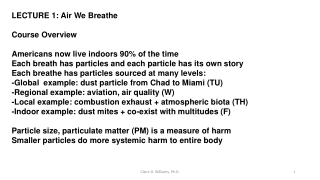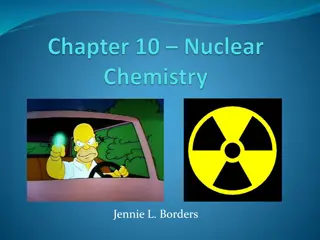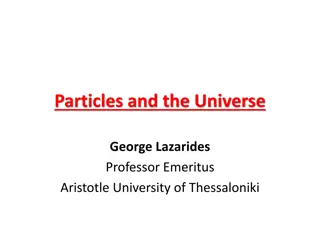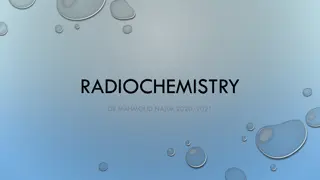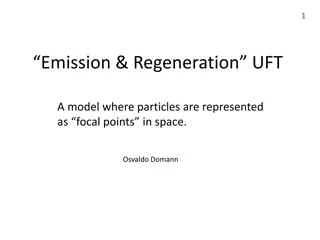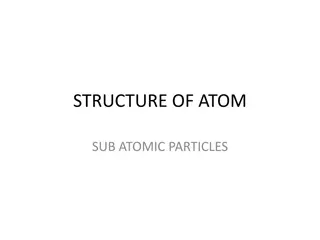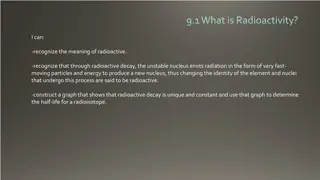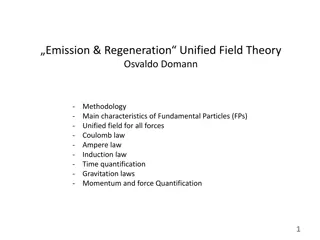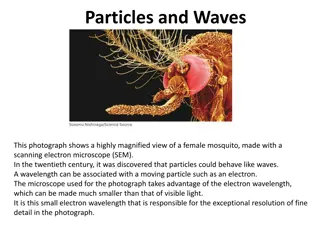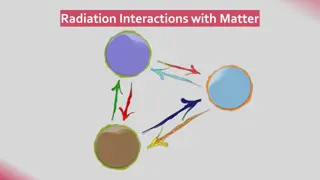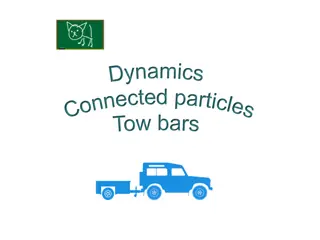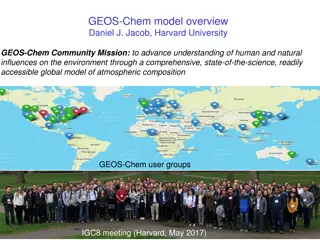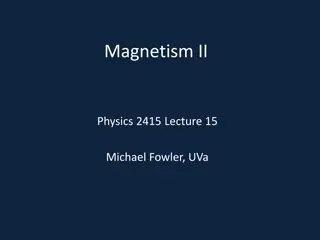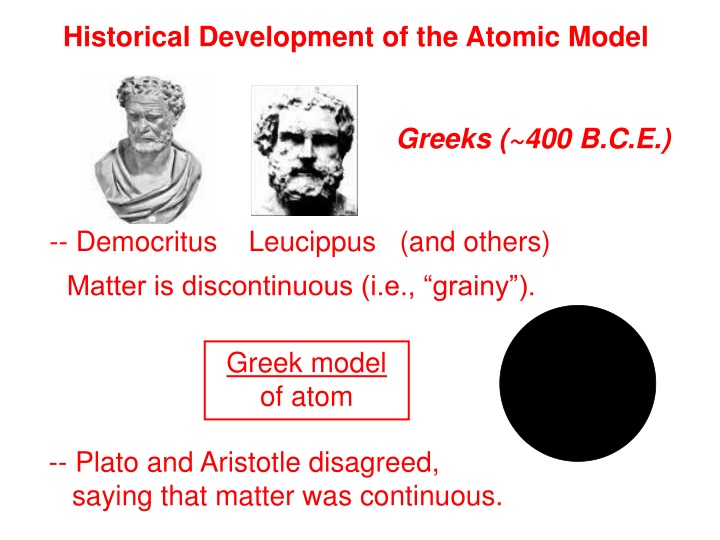
Development of Atomic Theory: From Greek Concepts to John Dalton's Model
Explore the historical journey of the atomic model, tracing back to the Greeks' ideas of matter as discontinuous grains to John Dalton's Atomic Theory in the 19th century. Contrasting the Greek BB model with Dalton's evidence-supported theory, this evolution sheds light on the scientific advancements in understanding the atom's structure and composition.
Download Presentation

Please find below an Image/Link to download the presentation.
The content on the website is provided AS IS for your information and personal use only. It may not be sold, licensed, or shared on other websites without obtaining consent from the author. If you encounter any issues during the download, it is possible that the publisher has removed the file from their server.
You are allowed to download the files provided on this website for personal or commercial use, subject to the condition that they are used lawfully. All files are the property of their respective owners.
The content on the website is provided AS IS for your information and personal use only. It may not be sold, licensed, or shared on other websites without obtaining consent from the author.
E N D
Presentation Transcript
Historical Development of the Atomic Model Greeks (~400 B.C.E.) -- Democritus Leucippus (and others) Matter is discontinuous (i.e., grainy ). Greek model of atom -- Plato and Aristotle disagreed, saying that matter was continuous.
Hints at the Scientific Atom -- Antoine Lavoisier: law of conservation of mass -- Joseph Proust (1799): law of definite proportions: every compound has a fixed proportion by mass mass units e.g., water . 8 m.u. O : 1 m.u. H 13 m.u. Cr : 4 m.u. O chromium(II) oxide ..
Hints at the Scientific Atom (cont.) -- John Dalton (1803): law of multiple proportions: When two different compounds have same two elements, equal mass of one element results in integer multiple of mass of other. e.g., water .. hydrogen peroxide.. . 8 m.u. O 16 m.u. O 1 m.u. H : 1 m.u. H : 13 m.u. Cr 4 m.u. O 13 m.u. Cr 12 m.u. O : : chromium(II) oxide .. chromium(VI) oxide .
John Daltons Atomic Theory (1808) 1. Elements are made of indivisible particles called atoms. 2. Atoms of the same element are exactly alike; in particular, they have the same mass. 3. Compounds are formed by the joining of atoms of two or more elements in fixed, whole number ratios. e.g., 1:1, 2:1, 1:3, 2:3, 1:2:1 Dalton s model of atom Dalton s was the first atomic theory that had evidence to support it. NaCl, H2O, NH3, Fe2O3, C6H12O6
John Daltons Atomic Theory (1808) 1. Elements are made of indivisible particles called atoms. 2. Atoms of the same element are exactly alike; in particular, they have the same mass. 3. Compounds are formed by the joining of atoms of two or more elements in fixed, whole number ratios. e.g., 1:1, 2:1, 1:3, 2:3, 1:2:1 Dalton s model of atom Dalton s was the first atomic theory that had evidence to support it.
FINAL THOUGHTS: Atomic Theory, 1 1. The ancient Greeks were the first known humans to theorize about matter on the scale of the very small. Some Greeks (by no means all) concluded that matter was particulate in nature; thus was born the Greek BB model of the atom. 2. In the early 19th century, John Dalton formulated his atomic theory, based on his own scientific work and that of Lavoisier and Proust. While Dalton s model of the atom differed little from the Greek BB model, Dalton s was supported by empirical evidence, while the Greek model was pure conjecture.
Law of Electrostatic Attraction opposite charges attract; like charges repel ATTRACTIVE REPULSIVE + + + (also called coulombic attraction)
-- William Crookes (1870s): Rays causing shadow were emitted from the cathode. Maltese cross CRT computer monitor radar screen television
-- J.J. Thomson (1897) discovered that cathode rays are deflected by electric and magnetic fields. He found that cathode rays were particles (today, we call them electrons) having a charge- to-mass ratio of 1.76 x 108 C/g. electric field lines cathode rays + + + + + + Crooke s tube phosphorescent screen electrons ( ) particles
Since atom was known to be electrically neutral, he proposed the plum pudding model. -- Equal quantities of (+) and ( ) charge distributed uniformly in atom. + + + + ++ -- (+) is ~2000X more massive than ( ). + + + + + (plum pudding) Thomson s plum pudding model
-- Robert Millikan (1909) performed the oil drop experiment. Oil drops were given negative charges of varying magnitude. (using x-rays) x-rays
Charges on oil drops were found to be integer multiples of 1.60 x 10 19 C. 6.40 x 10 19 C 4.80 x 10 19 C 1.60 x 10 19 C 3.20 x 10 19 C 1.60 x 10 19 C 6.40 x 10 19 C m g = q E 8.00 x 10 19 C 9.60 x 10 19 C 8.00 x 10 19 C 4.80 x 10 19 C 1.60 x 10 19 C 6.40 x 10 19 C 9.60 x 10 19 C 3.20 x 10 19 C He reasoned that this must be the charge on a single electron. He then found the electron s mass: charge 1.60 x 10 19 C = charge per mass 1.76 x 108 C/g previously discovered by Thomson = 9.09 x 10 28 g
FINAL THOUGHTS: Atomic Theory, 2 1. Thomson modified Dalton s model of the atom when he realized that atoms contain smaller, subatomic particles: some with a (+) charge, and electrons, with a ( ) charge. Thus, Dalton s solid blob model gave way to Thomson s mushy-squooshy plum pudding model. J.J. didn t figure out either the e s charge nor mass, but did find its charge-to-mass ratio. 2. In his oil-drop experiment, Millikan was able to determine the charge on an electron. Then, from Thomson s charge-to-mass ratio, he calculated the electron s mass.
Ernest Rutherford (1910): Gold Leaf Experiment A beam of -particles (+) was directed at a gold leaf surrounded by a phosphorescent (ZnS) screen. gold leaf particle beam -source lead block ZnS screen
Most -particles passed through, some angled slightly, and a tiny fraction bounced back. Conclusions: 1. Atom is mostly empty space. (+) particles are concentrated at center. nucleus = little nut ( ) particles orbit nucleus. 3. 2.
-- James Chadwick discovered neutrons in 1932. Purpose of n0 = help to bind p+ together in nucleus And now we believe in many other subatomic particles: quarks, muons, positrons, neutrinos, pions, etc. photo from liquid H2 bubble chamber
Thomsons Plum Pudding Model Rutherford s Model Dalton s (also the Greek) Model + + + + + + + + N + + +
FINAL THOUGHTS: Atomic Theory, 3 1. In his gold leaf experiment, Rutherford showed that that the atom was mostly empty space, and that the atom s (+) particles were concentrated at the center. Rutherford is thus credited with the concept of the nuclear atom. 2. Chadwick determined that the atomic nucleus contained more than just (+) particles; there are also uncharged particles, which we call neutrons. 3. We ll discuss the current-best model of the atom, the quantum-mechanical model, in some detail in a later unit.
electronic charge =1.602 x 1019 C -- In chemistry, charges are expressed as unitless multiples of this value, not in C. e.g.,2+ (as in Ca2+), not 2 (1.602 x 10 19 C) = 3.204 x 10 19 C -- atomic mass unit (amu): used to measure masses of atoms and subatomic particles 1 p+ = 1.0073 amu 1 n0 = 1.0087 amu 1 e = 0.0005486 amu ~ ~ i.e., mp+ = mn0 = 1 amu Conversion:1 g = 6.02 x 1023 amu (MEMORIZE.)
Angstroms (A) are often used to measure atomic dimensions. 1 A = 1 x 10 10 m = 1 x 10 8 cm Conversion: atomic number:# of p+ -- the whole number on Periodic Table; determines the identity of an atom mass number:(# of p+) + (# of n0) isotopes: different varieties of an element s atoms -- same # of p+, diff. # s of n0 (thus, diff. masses) -- some are radioactive; others aren t -- A nucleus of a specific isoto called a nuclide. All atoms of an element react the same, chemically. STOP
Complete Atomic Designation gives precise info about an atomic particle mass # charge (if any) element symbol atomic # 125 I 53 iodine is now added to salt Goiter due to lack of iodine
Complete Atomic Designation 238 92U 23 11 79 34 Protons Neutrons Electrons 92 146 92 + 11 12 10 Na 2 34 45 36 Se 59 27 37 17 55 25 3+ 27 32 24 Co 17 20 18 Cl 7+ 25 30 18 Mn STOP
Average Atomic Mass (a.k.a., Atomic Mass or Atomic Weight) This is the weighted average mass of all atoms of an element, measured in a.m.u. For an element with isotopes A, B, etc.: Ti has five naturally- occurring isotopes AAM = Mass A (% A) + Mass B (% B) + % abundance (use the decimal form of the %; e.g., use 0.253 for 25.3%)
Lithium has two isotopes. Li-6 atoms have mass 6.015 amu; Li-7 atoms have mass 7.016 amu. Li-6 makes up 7.5% of all Li atoms. Find AAM of Li. AAM = Mass A (% A) + Mass B (% B) Li batteries AAM = 6.015 amu (0.075) + 7.016 amu (0.925) AAM = 0.451 amu + 6.490 amu AAM = 6.94 amu ** Decimal number on Table refers to molar mass (in g) OR AAM (in amu). 6.02 x 1023 atoms 1 average atom
% Isotope Mass abundance 92.23% 4.67% 3.10% Si-28 Si-29 Si-30 27.98 amu 28.98 amu ? AAM = MA (% A) + MB (% B) + MC (% C) = 27.98 (0.9223) + 28.98 (0.0467) + X (0.031) 28.086 28.086 = 25.806 + 1.353 + 0.031X 28.086 = 0.927 = 0.031X 0.031 X = MSi-30 = 29.90 amu STOP 27.159 + 0.031X 0.031
The group: a vertical column; elements in a group share certain phys. and chem. properties Periodic Table metals nonmetals metalloids -- group 1 = alkali metals -- group 2 = alkaline earth metals -- group 16 = chalcogens -- group 17 = halogens -- group 18 = noble gases
Molecular compounds contain only nonmetals. empirical formula:shows relative #s of each type of atom in m cule (CH2) molecular formula:shows actual #s & types of atoms in m cule (C3H6) structural formula:shows which atoms are bonded to which Also perspective drawing stick model model F F C F F Just like a Lewis structure, but w/o unshared pairs. ball-and- space-filling
Nomenclature of Binary Molecular Compounds (two types of nonmetals) FORGET CHARGES! Use Greek prefixes to indicate how many atoms of each element, but don t use mono on first element. hexa hepta octa nona dec 1 2 3 4 5 mono di tri tetra penta 6 7 8 9 10 Also, don t use any prefixes if H is the first element e.g., H2S HF HCl
CO2 carbon monoxide N2O3 dinitrogen pentoxide carbon dioxide CO dinitrogen trioxide N2O5 carbon tetrachloride CCl4 nitrogen triiodide NI3 STOP
ion: a charged particle (i.e., a charged atom or group of atoms) Ions and Ionic Compounds anion: a ( ) ion -- more e than p+ cation: a (+) ion -- more p+ than e a cation a fish a cat keeping anion a fish -- -- formed when atoms gain e formed when atoms lose e Anions are negative ions. When I see a cation, I see a positive ion; A + that is, I C ion.
polyatomic ion: a charged group of atoms Memorize: NH4+ CH3COO PO43 MnO4 ammonium acetate phosphate permanganate NO3 ClO3 BrO3 IO3 nitrate chlorate bromate iodate chromate dichromate CN OH cyanide hydroxide CrO42 Cr2O72 carbonate bicarbonate sulfate bisulfate CO32 HCO3 SO42 HSO4
Ionic compounds, or salts, consist of oppositely-charged species bonded by electrostatic forces. You can describe salts as metal-nonmetal, but cation-anion is better.
Nomenclature of Ionic Compounds chemical formula: has neutral charge; shows types of atoms and how many of each To write an ionic compound s formula, we need: 1. the two types of ions 2. the charge on each ion NaF Na+ and F BaO Na2O BaF2 Ba2+ and O2 Na+ and O2 Ba2+ and F
Parentheses are reqd only with multiple bunches of a particular polyatomic ion. Ba2+ and SO42 Mg2+ and NO2 NH4+ and ClO3 Sn4+ and SO42 Fe3+ and Cr2O72 NH4+ and N3 BaSO4 Mg(NO2)2 NH4ClO3 Sn(SO4)2 Fe2(Cr2O7)3 (NH4)3N
SUMMARY: Introduction to Ionic Nomenclature 1. An ion is a particle with an unequal number of p+ and e . Anions have gained one or more e , and so have a net ( ) charge; cations have lost one or more e , and so have a net (+) charge. 2. A polyatomic ion is a covalently-bonded GROUP of atoms that have an unequal number of p+ and e . 3. Ionic compounds, or salts, consist of cations and anions ionically bonded to each other. 4. Parentheses are used in chemical formulas only when we have more than one clump of a particular polyatomic ion.
Fixed-Charge Cations with Elemental Anions i.e., pulled-off-the- Table anions For this class, the fixed-charge cations are groups 1, 2, 13, and Ag+, Zn2+, Cd2+, Sc3+, Y3+, Zr4+, Hf4+, Ta5+.
Na A. To name, given the formula: Ba 1. Use name of cation. 2. Use name of anion (it has the ending ide ). sodium fluoride NaF barium oxide BaO sodium oxide Na2O BaF2 barium fluoride
Zn Ca Ag B. To write formula, given the name: 1. Write symbols for the two types of ions. 2. Balance charges to write formula. Ag+ Ag2S S2 silver sulfide Zn2+ P3 Zn3P2 zinc phosphide I CaI2 Ca2+ calcium iodide STOP
Variable-Charge Cations with Elemental Anions i.e., pulled-off-the- Table anions For this class, the variable-charge cations are Pb2+/Pb4+, Sn2+/Sn4+, and all transition elements not listed above.
A. To name, given the formula: Cu Fe 1.Figure out charge on cation. 2. Write name of cation. 3. Write Roman numerals in ( ) to show cation s charge. 4. Write name of anion. Stock System of nomenclature Fe? Fe2+ iron(II) oxide FeO O2 Fe3+ Fe? O2 O2 Fe2O3 CuBr Fe3+ Fe? O2 iron(III) oxide Cu? Br Cu+ copper(I) bromide CuBr2 Cu2+Br Cu? copper(II) bromide Br
B. To find the formula, given the name: 1. Write symbols for the two types of ions. 2. Balance charges to write formula. Co Sn cobalt(III) chloride Co3+Cl CoCl3 Sn4+ O2 SnO2 tin(IV) oxide Sn2+ tin(II) oxide O2 SnO STOP
Insert name of ion where it should go in the compound s name. But first... oxyanions: polyatomic ions containing oxygen Most common oxyanions: BrO3 IO3 ClO3 NO3 nitrate bromate iodate chlorate PO43 SO42 CO32 phosphate sulfate carbonate
If an oxyanion differs from the above by the # of O atoms, the name changes are as follows: one more O = per_____ate most common # of O = _____ate one fewer O = _____ite two fewer O = hypo_____ite
Write formulas: iron(III) nitrite Fe3+NO2 Fe(NO2)3 (NH4)3P NH4ClO2 Zn3(PO4)2 ammonium phosphide NH4+ NH4+ Zn2+PO43 Pb2+MnO4 Pb(MnO4)2 P3 ClO2 ammonium chlorite zinc phosphate lead(II) permanganate
Write names: (NH4)2SO4 ammonium sulfate silver bromate AgBrO3 (NH4)3N ammonium nitride CrO42 U6+ uranium(VI) chromate U?CrO42 CrO42 Cr? Cr? Cr3+SO32 SO32 U(CrO4)3 Cr2(SO3)3 chromium(III) sulfite Cr3+ SO32 STOP
Acid Nomenclature binary acids: acids w/H and one other element Binary Acid Nomenclature 1. Write hydro. 2. Write prefix of the other element, followed by -ic acid. HF HCl hydrofluoric acid hydrochloric acid hydrobromic acid HBr hydroiodic acid HI hydrosulfuric acid H2S
oxyacids: acids containing H, O, and one other element Oxyacid Nomenclature For most common forms of the oxyanions, write prefix of oxyanion, followed by -ic acid. HBrO3 HClO3 H2CO3 sulfuric acid bromic acid chloric acid carbonic acid H2SO4 H3PO4 phosphoric acid
If an oxyacid differs from the above by the # of O atoms, the name changes are: one more O = per_____ic acid most common # of O = _____icacid one fewer O = _____ous acid two fewer O = hypo_____ous acid HClO4 HClO3 HClO2 HClO perchloric acid chloric acid chlorous acid most common hypochlorous acid H3PO3 HBrO H2SO5 phosphorous acid hypobromous acid persulfuric acid STOP

